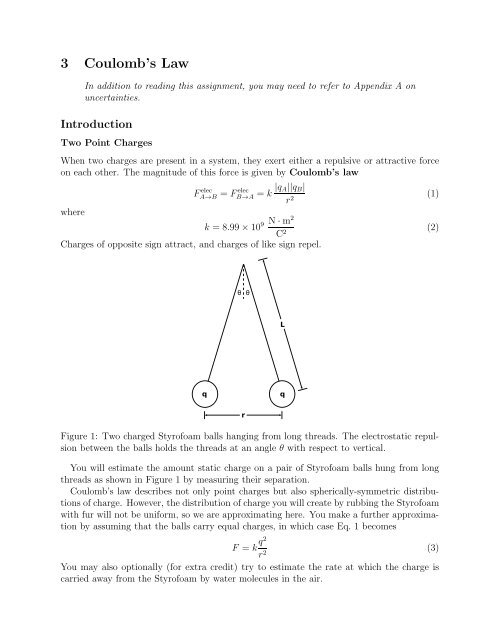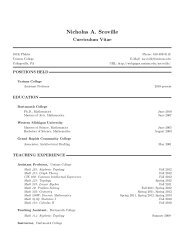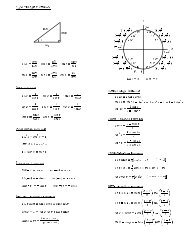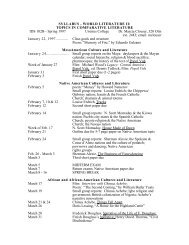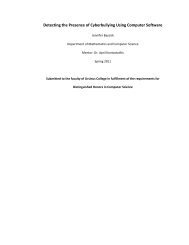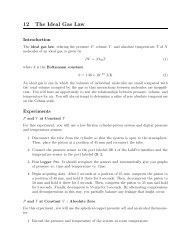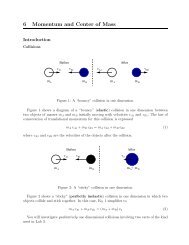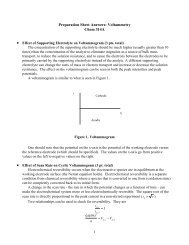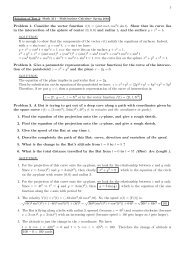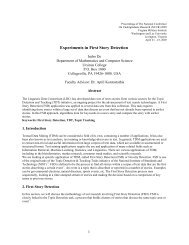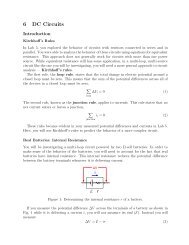Lab 3
Lab 3
Lab 3
- No tags were found...
Create successful ePaper yourself
Turn your PDF publications into a flip-book with our unique Google optimized e-Paper software.
3 Coulomb’s LawIn addition to reading this assignment, you may need to refer to Appendix A onuncertainties.IntroductionTwo Point ChargesWhen two charges are present in a system, they exert either a repulsive or attractive forceon each other. The magnitude of this force is given by Coulomb’s lawwhereF elecA→B = Felec B→A = k |q A||q B |r 2 (1)k = 8.99×10 9 N·m2C 2 (2)Charges of opposite sign attract, and charges of like sign repel.Figure 1: Two charged Styrofoam balls hanging from long threads. The electrostatic repulsionbetween the balls holds the threads at an angle θ with respect to vertical.You will estimate the amount static charge on a pair of Styrofoam balls hung from longthreads as shown in Figure 1 by measuring their separation.Coulomb’s law describes not only point charges but also spherically-symmetric distributionsof charge. However, the distribution of charge you will create by rubbing the Styrofoamwith fur will not be uniform, so we are approximating here. You make a further approximationby assuming that the balls carry equal charges, in which case Eq. 1 becomesF = k q2r 2 (3)You may also optionally (for extra credit) try to estimate the rate at which the charge iscarried away from the Styrofoam by water molecules in the air.
Figure 2: Illustration of the distribution of charges on an electroscope when a negativelycharged rod is brought near its electrode.The ElectroscopeAn electroscope is a device designed to detect the presence of charge. It consists of aconducting electrode connected to a conducting needle and its support structure all of whichare mounted on a stand and isolated from the stand and the environment by an insulatingcollar. Bringing a charged object near the electrode induces a charge of opposite sign on theelectrode by forcing a charge of like sign to migrate from the electrode down to the needleand its support structure. This charge distributes itself over the needle and its support,resulting in a change of orientation of the needle as shown in Figure 2.You can make sense of the behavior of charge on conductors in general and of the behaviorof an electroscope in particular if you understand a few basic concepts:1. Any net charge on an isolated conducting object distributes itself on the surface of theobject such that each charge is as far away from neighboring charges as possible.On a sphere, this means the charge distributes itself uniformly over the surface. On anirregularly shaped conducting solid, a net charge is not uniformly distributed, tendingto collect in higher density at sharp edges and points, but any net charge always resideson the surface. On an electroscope, this means that an induced charge will cover boththe needle and its support structure, causing the needle to deflect.2. The net charge on an isolated conductor remains constant.However, you will not be able to truly isolate conductors in the laboratory, becausewater molecules in the air slowly bleed the charge from charged objects.3. An electrical ground is a large conducting body which acts as an effectively infinitesource/sink for charge.
Grounded outlets in a building are typically connected to the plumbing, which iseffectively a connection to the entire planet. Your body is a reasonable approximationto electrical ground with regard to small objects like an electroscope.4. In the presence of external charge, opposite charges will be attracted to points on thesurface of the conductor nearest to the external charge.See for example the positive charge induced on the electrode of the electroscope inFigure 2 by a negatively charged rod.Experiments and AnalysisTwo Point Charges1. Measure the mass m of the Styrofoam balls on the balance at the front of the lab anddetermine the associated uncertainty.2. Hang the threads from the rod from the loop above the knot in the thread, and makesure the strings are not twisted around each other so that the balls are hanging froma well-defined point (the knot).3. With the system at rest, measure the distance from the knot to the center of the ballsas precisely as you can.4. Rub each ball with the fur, being careful not to touch the balls after charging them.5. Make sure the threads don’t twist around each other, and hold the threads to bringthe system to rest.6. Devise a methodformeasuring the distance r between thecenters ofthe two Styrofoamballs. Use your method to measure r and determine the associated uncertainty.7. Derive an equation giving the charge q on each ball in terms of r, L, m, g, andk. Assume that the balls carry equal charge. Draw a free body diagram and applyNewton’s second law in two dimensions. Feel free to consult with your instructor.8. Use theequation youderived andyour measured m andrvalues to calculate thechargeq on each ball. Assume the local acceleration due to gravity is g = 9.80±0.05 m/s 2 .Also determine the uncertainty of your result.The ElectroscopePrior to performing each of the following experiments, be sure to ground the electroscope bytouching the electrode with your finger. For best results, re-charge the plastic rod often byrubbing it with the fur.For each experiment, record what you observe, explain it, and as part of your explanation,sketch a diagram, or series of diagrams, similar to Figure 2 that accounts for your observations.Your sketches should show qualitatively the distribution of charge on the electroscopeand the other objects involved.
1. Observe the electroscope while moving the rod near the electrode without touching it,and then move it away.2. Rub the charged rod on the electrode, and then move it away again.3. Touch the electrode of the electroscope with your finger and hold it there. Bring therod close to the the electrode, but not so close that you transfer any charge to theelectrode (you shouldn’t hear any sparks). While still holding the rod nearby, removeyour finger from the electrode. Then, move the rod away.4. Hold a flat sheet of aluminum foil over the electrode of the electroscope, parallel to itbut without touching the electrode with the foil. Observe the electroscope while youbring the charged rod close to the foil from above.Extra CreditIf you have completed the work described above and time permits, determine experimentallythe ratei = ∆q∆tat which charge leaves the Styrofoam balls, along with its uncertainty, using a method youdevise.Before You Leave <strong>Lab</strong>Discuss with your instructor preliminary responses to the individual assignment below.Hand In ...... responses to the following.1. Describe your method of finding the separation r between the centers of the Styrofoamballs in the point-charge experiment. Also describe how you determined the associateduncertainty.2. Give the derivation of your equation for the charge q on each of the balls in the pointchargeexperiment. Include a free-body diagram. Report your result. Include itsuncertainty, and describe how you got it.3. The uncertainty you gave in your response to question 2 is based on propagation ofexperimental uncertainties. Now, consider the approximations you made in derivingyour equation for q — that the charges on the balls were (a) equal and (b) evenly distributed.Estimate the uncertainty in q associated with each of these approximations.That is, assume that the balls had unequal charges that were not uniformly spreadover their surfaces. How would these imbalances affect your results? You will need touse your judgement here as far as how unequal the charges could have actually beenand how uneven the charge could have been distributed.
4. For the electroscope experiments, give your observations, explanations, and sketches.5. If you completed the extra credit assignment, describe the method you devised andreport your data and results.


